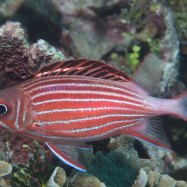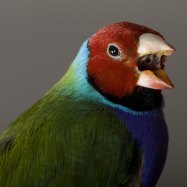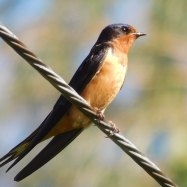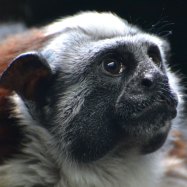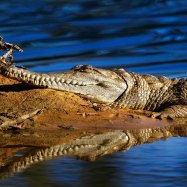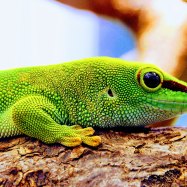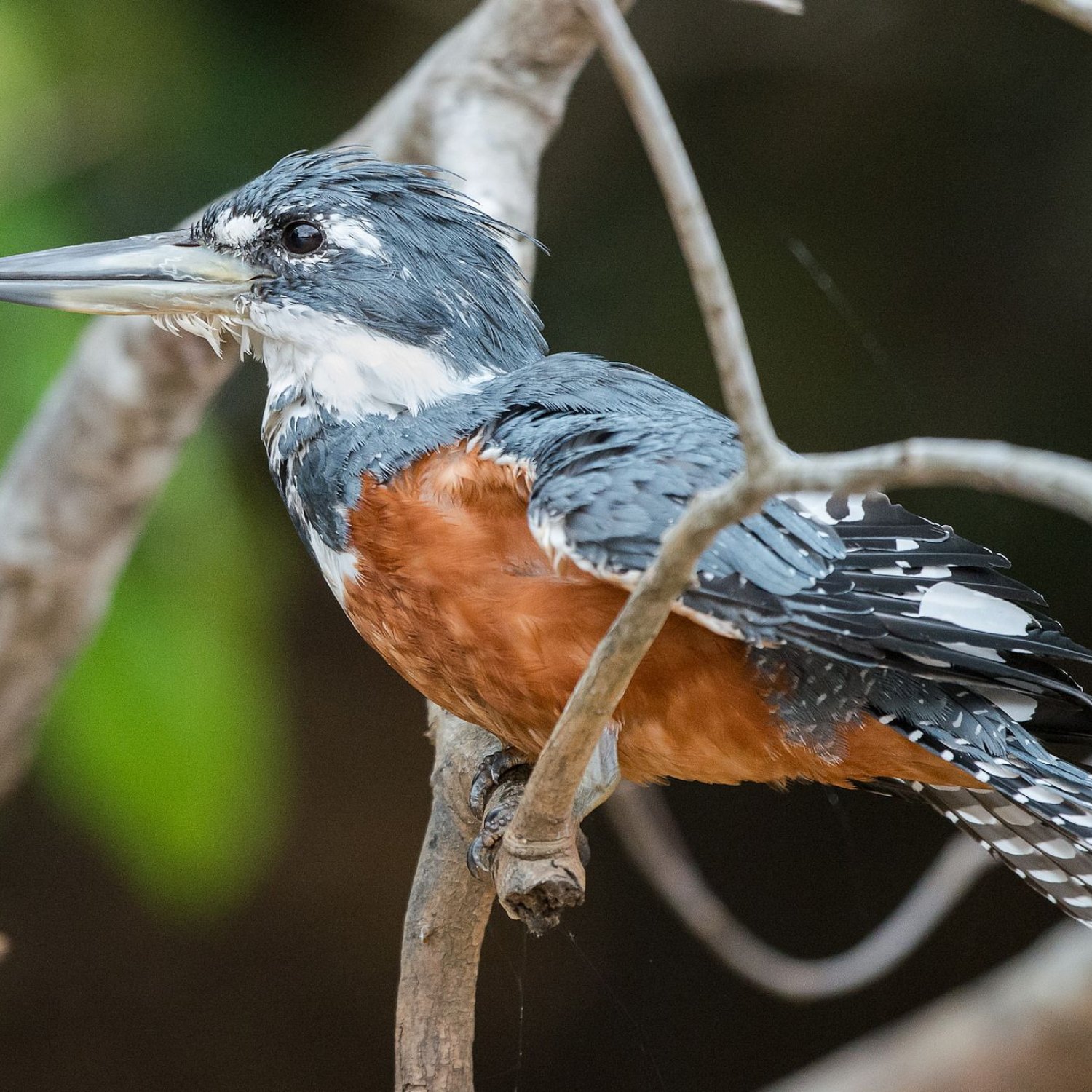
Ringed Kingfisher
29-35 cm
The Ringed Kingfisher, found in North, Central, and South America, is a stunning bird with a long bill and robust body. Belonging to the Alcedinidae family, these birds can reach a length of 29-35 cm. They are known for their loud, rattling calls and are commonly found near water bodies. Keep an eye out for this magnificent species on your next nature walk! #RingedKingfisher #birdwatching #naturelovers
Animal Details Summary:
Common Name: Ringed Kingfisher
Kingdom: Animalia
Habitat: Rivers, streams, lakes, and coastal areas
Ringed Kingfisher: The Mighty Hunter of the Americas
Life in the animal kingdom can be fierce and competitive. Creatures of all shapes and sizes must use unique adaptations to survive in their respective environments. Some animals have developed extraordinary abilities, while others rely on their physical characteristics to thrive. One such animal is the Ringed Kingfisher Ringed Kingfisher.The Ringed Kingfisher, scientifically known as Megaceryle torquata, is a magnificent bird that belongs to the Animalia kingdom, Chordata phylum, and Aves class. It is a member of the Coraciiformes order and the Alcedinidae family, which consists of approximately 90 species of kingfishers, all with distinct features. But the Ringed Kingfisher stands out with its striking coloration, impressive hunting techniques, and widespread presence in North, Central, and South America.
The Habitat
Ringed Kingfishers thrive in a range of environments, from rivers and streams to lakes and coastal areas. These birds can be found from southern Texas, USA, through Central America, all the way down to central Argentina. They are highly adaptable and can survive in both freshwater and saltwater habitats.The wide distribution of Ringed Kingfishers is mainly due to their diverse feeding habits. They are commonly found near bodies of water, but can also be seen in grasslands, mangroves, and open forest areas. These birds are territorial and defend their chosen fishing spot, often perching on a high branch or telephone wire to keep watch over their territory Red Wolf.
The Feeding Method
Ringed Kingfishers are carnivorous birds that hunt primarily by diving into the water to catch fish. They use their keen eyesight to locate fish near the surface and then use their long, sharp bill to pierce through the water and grasp their prey. These birds are incredibly skilled hunters, capable of catching fish of various sizes, including small crustaceans and insects.Unlike other kingfisher species that catch their prey by hovering over the water, Ringed Kingfishers prefer to perch on a high branch or rock and then dive headfirst into the water. This technique is known as plunge-diving and allows them to catch their prey at incredible speeds. They are excellent swimmers and can dive up to six feet underwater, emerging with their catch in their sharp bill.
The Physical Appearance
One of the striking features of the Ringed Kingfisher is its unique coloration. Their upperparts are a bright blue-green, while their underparts are pure white. They also have a distinctive blue crown on their head, which adds to their overall elegance. These colors act as camouflage, blending in with the surrounding water and foliage, making it easier for them to hunt and avoid predators.In addition to their coloration, the Ringed Kingfisher has a robust body, a large head, and a long, thick bill. These physical traits are essential for their hunting technique, allowing them to have better control and precision when diving into the water. They also have sharp, pointed claws for gripping onto their catch.
The Body Shape and Size
Ringed Kingfishers have a large, stocky body, with a wingspan that can reach up to 50 cm. Their bill alone can measure up to 8 cm in length, making it one of the longest in the kingfisher family. These birds have a unique body shape, with a compact head and a short tail. Their wings are broad and rounded, allowing them to maneuver and dive underwater effortlessly.The average length of a Ringed Kingfisher is between 29 to 35 cm, with males slightly larger than females. They can weigh up to 200 grams, making them one of the heaviest kingfisher species.
The Country of Origin and Distribution
Ringed Kingfishers are native to North, Central, and South America, where they can be found in a vast range of habitats. These birds are year-round residents in their respective territories and do not migrate to other regions. They are most commonly found in Mexico, the Caribbean, the United States, Costa Rica, and Argentina.In addition to their range and distribution in the Americas, Ringed Kingfishers have also been introduced to other parts of the world, such as Puerto Rico, Jamaica, and Cayman Islands. However, their numbers in these regions are not as abundant as their native territories.
The Behavior
Ringed Kingfishers are primarily solitary animals, only coming together for mating and nesting purposes. These birds are active during the day and spend most of their time perched on a high vantage point, from where they can keep an eye on their territory. They are also vocal animals, using a variety of calls to communicate with other birds, mostly to send warning signals.Despite their fierce and solitary nature, Ringed Kingfishers are monogamous and mate for life. They build their nests in burrows on the banks of rivers or lakes, often excavating their own nesting holes in mud or sandbanks. Both parents take part in incubating the eggs, with the mother doing most of the work, while the father provides food for the family.
The Conservation Status
According to the International Union for Conservation of Nature (IUCN), the Ringed Kingfisher is listed as a species of least concern. Their widespread distribution and adaptability have contributed to their stable population numbers. However, like many other animals, they face threats such as habitat loss and pollution, especially in coastal areas where they feed.To ensure the continued survival of the Ringed Kingfisher and other species, it is vital to protect their habitats and raise awareness about the impact of human activities on the environment. Initiatives like beach cleanups and conservation efforts can go a long way in preserving the natural home of these beautiful birds.
The Significance of Ringed Kingfishers
Ringed Kingfishers play a crucial role in the ecosystem as top predators. Their hunting methods and diet help regulate fish populations in their habitat, ensuring a balance in the ecosystem. They are also indicators of the health of their environment and can serve as ambassadors for conservation efforts.Moreover, Ringed Kingfishers are also beneficial to humans. They provide natural pest control by feeding on insects and small crustaceans, and their presence can act as a source of ecotourism, bringing in revenue and promoting conservation efforts.
In Conclusion
In the vast and diverse world of birds, the Ringed Kingfisher stands out as a fascinating creature. They are fierce hunters, with distinct physical features and behaviors that have allowed them to thrive in various environments. These birds have captivated many with their beauty and remarkable hunting techniques, making them an essential part of the natural world.Through conservation efforts and responsible actions, we can ensure that the Ringed Kingfisher continues to soar in the skies, gracing the rivers and lakes of the Americas with its majestic presence. Let us protect these magnificent creatures and preserve their home for generations to come.

Ringed Kingfisher
Animal Details Ringed Kingfisher - Scientific Name: Megaceryle torquata
- Category: Animals R
- Scientific Name: Megaceryle torquata
- Common Name: Ringed Kingfisher
- Kingdom: Animalia
- Phylum: Chordata
- Class: Aves
- Order: Coraciiformes
- Family: Alcedinidae
- Habitat: Rivers, streams, lakes, and coastal areas
- Feeding Method: Carnivorous
- Geographical Distribution: From southern Texas, USA, through Central America, to central Argentina
- Country of Origin: North, Central, and South America
- Location: North, Central, and South America
- Animal Coloration: Blue-green upperparts, white underparts, and a blue crown
- Body Shape: Large head, robust body, long bill
- Length: 29-35 cm
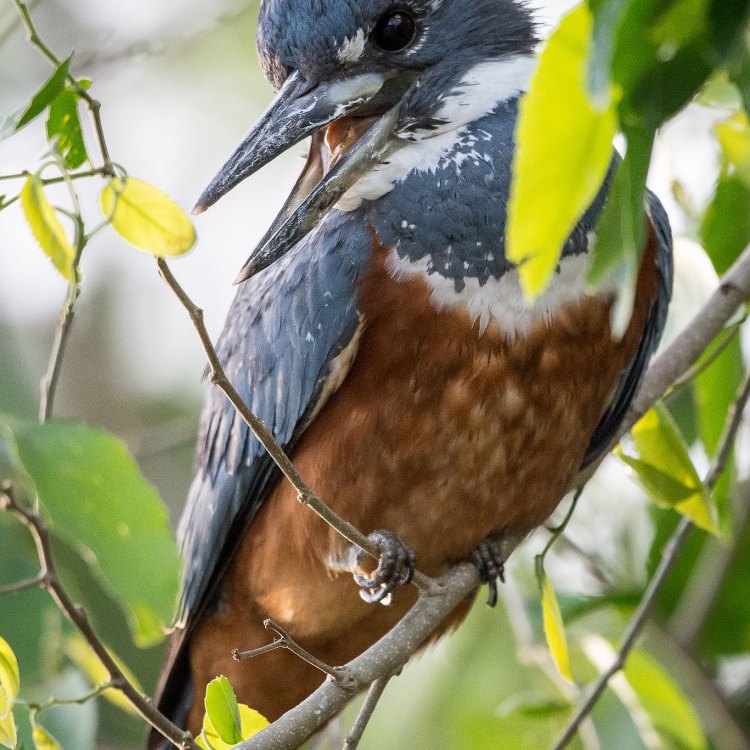
Ringed Kingfisher
- Adult Size: Medium-sized
- Average Lifespan: Up to 12 years in the wild
- Reproduction: Sexual
- Reproductive Behavior: Monogamous
- Sound or Call: Loud rattling or chattering call
- Migration Pattern: Non-migratory
- Social Groups: Solitary or in pairs
- Behavior: Dives into water to catch fish
- Threats: Habitat loss and degradation, pollution, hunting
- Conservation Status: Least Concern
- Impact on Ecosystem: Important predators of fish and small aquatic animals
- Human Use: Birdwatching, ecotourism
- Distinctive Features: Large size, long bill, blue-green coloration
- Interesting Facts: The Ringed Kingfisher is the largest kingfisher species found in the Americas
- Predator: Large birds of prey
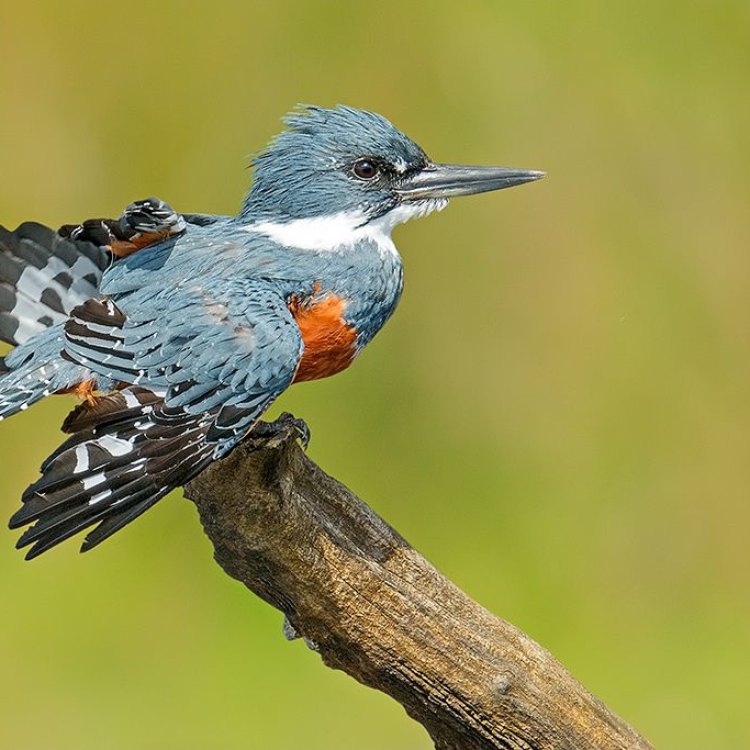
Megaceryle torquata
The Mighty Ringed Kingfisher: A Master Hunter of the Waters
It's a typical day in the lush rainforests of Central and South America. The sun is scorching, the air is humid, and the sound of water gushing through the rivers fills the air. Amidst this bustling ecosystem, a majestic bird can be seen perched on a branch overlooking a body of water. Its striking blue-green feathers and long bill make it stand out among the greenery – it's the mighty Ringed Kingfisher PeaceOfAnimals.Com.The Ringed Kingfisher (Megaceryle torquata) is a medium-sized bird found in Central and South America, from Mexico to Argentina. It is the largest kingfisher species found in the Americas, measuring up to 41 centimeters in length and weighing around 227 grams. It is also one of the most iconic birds in the region, known for its stunning appearance and impressive hunting abilities.
These kingfishers have an average lifespan of up to 12 years in the wild, during which they mate and reproduce via sexual reproduction. They have a monogamous reproductive behavior, meaning they form pairs with their mate and stay together for breeding and raising their young.
One of the most distinctive features of the Ringed Kingfisher is its loud rattling or chattering call, which can be heard from a long distance. This call is used for communication between mates, especially during the breeding season. It also serves as a warning to other kingfishers to stay away from their territory.
Unlike many bird species that migrate to different locations in search of food or better living conditions, Ringed Kingfishers are non-migratory Rhea. They are found in their designated territories year-round, which can range from rivers, lakes, streams, and even coastal areas.
These birds are mostly solitary or found in pairs, except during the breeding season when they form small social groups with their mate and offspring. Their behavior is quite fascinating to observe, as they have unique hunting techniques that make them stand out among other birds.
Ringed Kingfishers have a diverse diet, primarily consisting of fish, small reptiles, and aquatic insects. They are known for their impressive diving abilities, diving into the water from a height of up to 30 feet, and emerging with their prey in their sharp bill. This hunting technique is highly efficient and allows them to catch fish even in deep waters.
Unfortunately, like many animals in the wild, Ringed Kingfishers face several threats to their survival. Habitat loss and degradation due to deforestation, pollution of water bodies, and hunting for their feathers and meat are the main causes of their population decline. These kingfishers are also vulnerable to predators, such as large birds of prey.
Despite these threats, the Ringed Kingfisher's conservation status is labeled as 'least concern' by the International Union for Conservation of Nature (IUCN). This status is a testament to the species' adaptability and resilience in the face of changing environments.
Apart from their vital role in the ecosystem as top predators of fish and small aquatic animals, these birds also have a significant impact on humans. Their colorful and striking appearance makes them a popular birdwatching attraction, and many ecotourism initiatives have been developed to promote their conservation and raise awareness about their importance in the ecosystem.
One of the most fascinating things about Ringed Kingfishers is their distinctive features that make them stand out among other birds. Their large size, long bill, and blue-green coloration make them easily recognizable and admired by bird enthusiasts and tourists alike.
Did you know that the Ringed Kingfisher was once believed to be a symbol of bad luck in some cultures? In ancient Mayan civilizations, this bird was associated with drought and famine, and their feathers were used for ritual purposes. Today, however, they are widely appreciated and admired for their beauty and essential role in the ecosystem.
The presence of Ringed Kingfishers in an ecosystem also indicates the health of the water bodies. As top predators, their presence indicates an abundance of fish, which is crucial for maintaining the balance of aquatic ecosystems.
In conclusion, the Ringed Kingfisher is a magnificent bird that captures the heart and imagination of all those who encounter it. From its stunning appearance and impressive hunting abilities to its important role in the ecosystem and impact on human activities, this bird is truly a master of the waters. As we continue to strive towards preserving the natural world, it's vital to ensure the protection of these beautiful and ecologically significant birds so that future generations can also marvel at their magnificent presence.
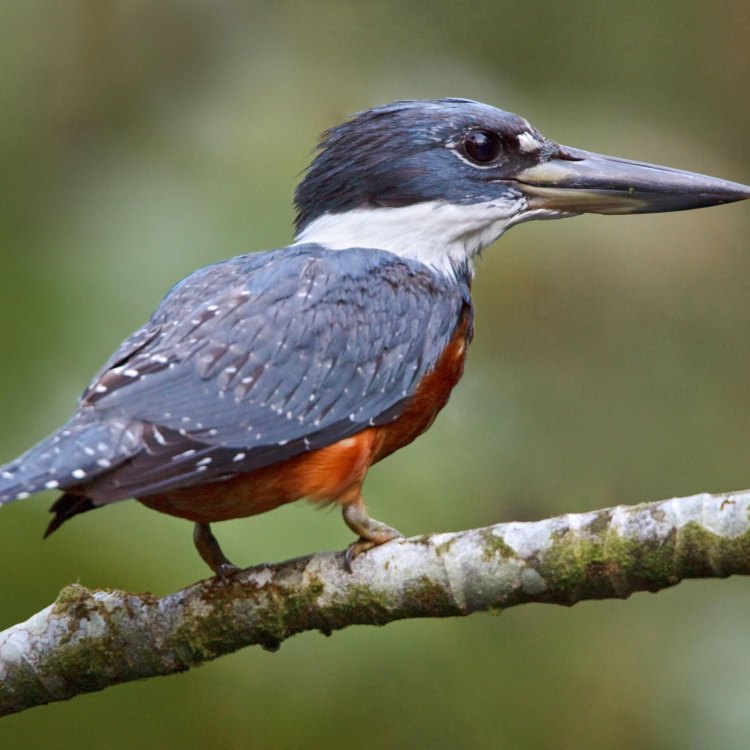
Ringed Kingfisher: The Mighty Hunter of the Americas
Disclaimer: The content provided is for informational purposes only. We cannot guarantee the accuracy of the information on this page 100%. All information provided here may change without prior notice.


